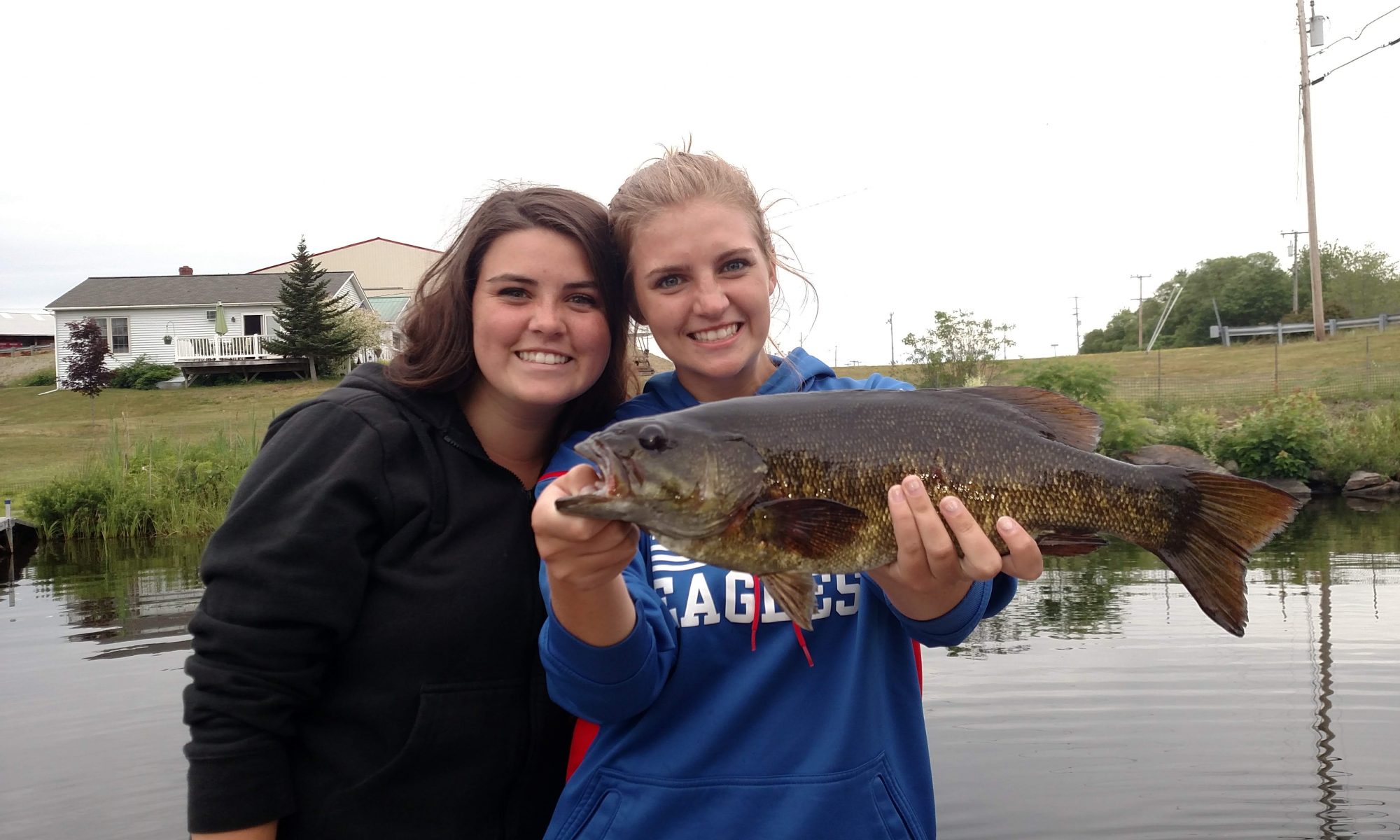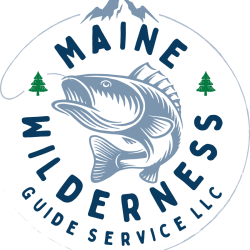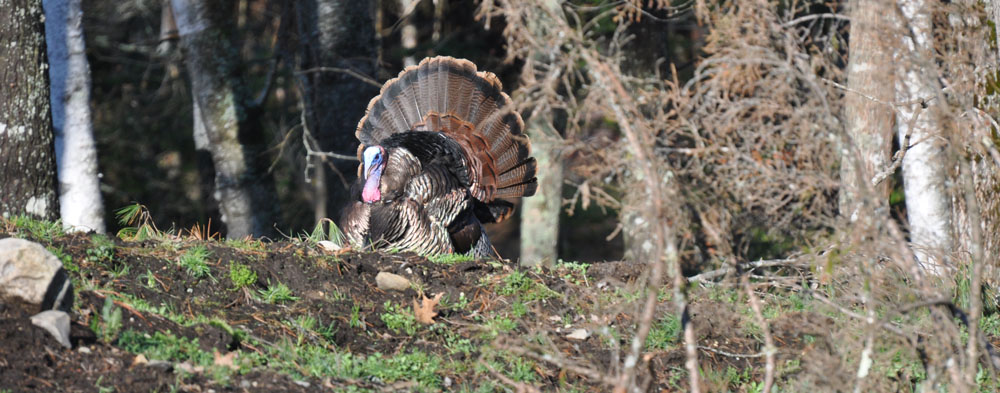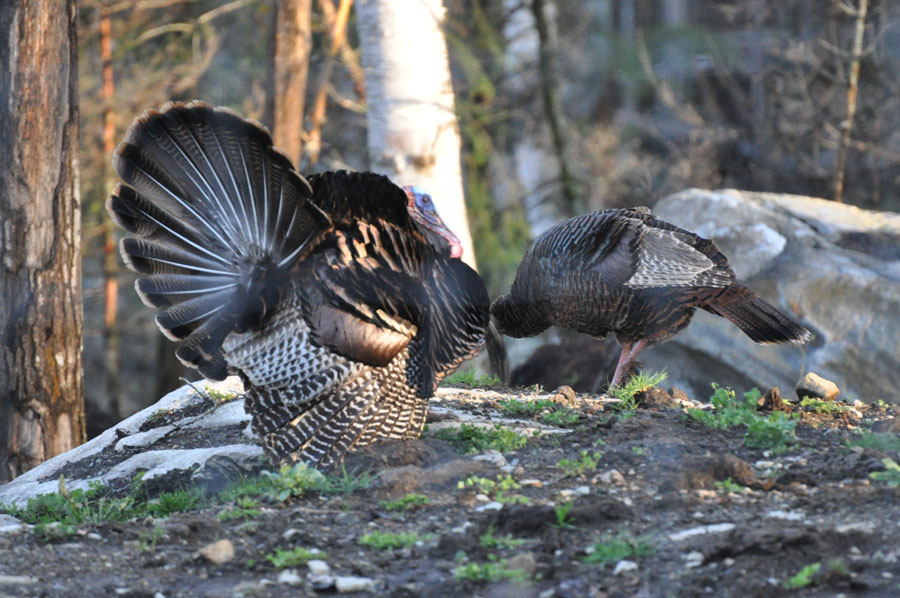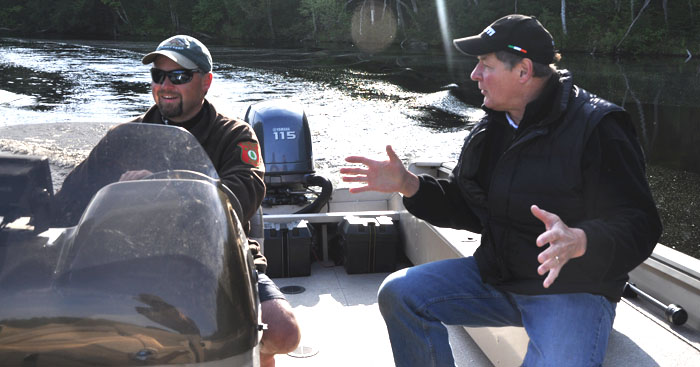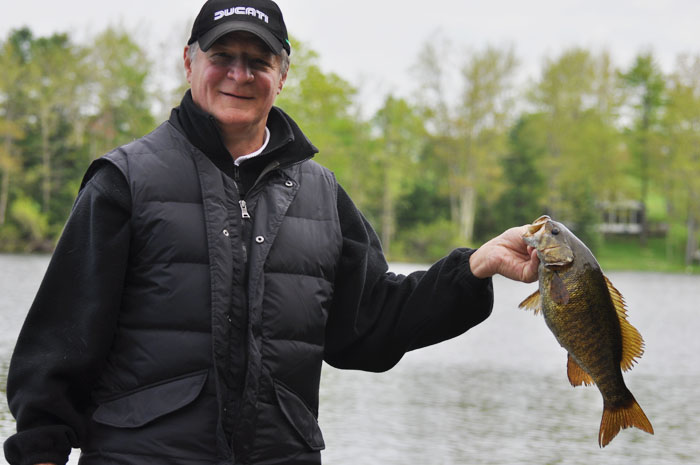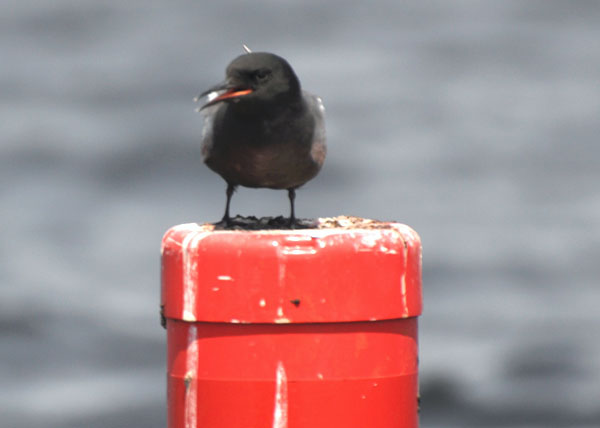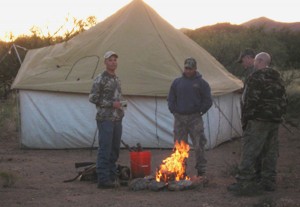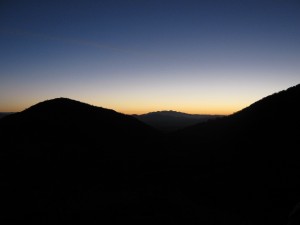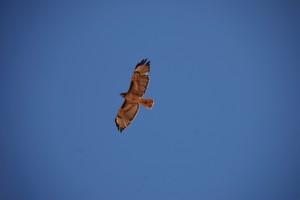There were so many highlights from this past week that’s it hard to pick a starting point! The fishing was great, the company was even better and the weather was really pretty good too. So many memories and stories to tell, but how about starting with all the little critters running, swimming, jumping, hopping and waddling around. For example, on Thursday morning around 5 a.m. I spotted my first flock of baby turkeys. There were three mother hen turkeys and 19 chicks (give or take a few – they are hard to count, and in my defense they all look the same). The hens kept a close watch on their brood and every time I tried to get close enough to take a picture they would shepherd the little ones away. I didn’t want to harass them too much, so I left well enough alone and headed to the lake. Once on the water, I had the privilege of fishing with my good friend Marty and his wife Gwen. My New Jerseyian friends come up and stay at Whisperwood every year, and we had a blast throwing Yamamoto swimming Senkos and spinnerbaits for largemouth bass. They even caught a few on top water, which is always a thrill. While on our trip, Marty told me that he has taken up photography and moments later a mother loon with two babies on her back swam around the corner. It was fate, karma, a gift from the loon gods! When the loon first rounded the bend, she didn’t realize we were there and dove to catch some fish. The little fluff balls bobbed around and minutes later momma popped up right next to them. As soon as she saw us, the babies were back up on their feathered raft! In the blink of an eye, the mother loon lifted her wing and hid the babes under the protection of her arm. If you didn’t know the babies were there, you would never have seen them. It was a great experience. Marty did get some photos of the loon and some terrific eagle shots later in the day. The bald eagles seem to be thriving this year, and it’s rare to not see an eagle on a morning’s fishing trip. Of course the baby ducks and geese are everywhere, along with lots of small turtles. Speaking of turtles, kudos to whoever had traffic stopped the other day on Route 27 in front of Hammond Lumber Company. That stubborn snapping turtle just didn’t want to cross the road, but you helped him make the trip safely. Being hit by cars is one of the leading causes of death for snapping turtles, which can live to be over 50 years old. Plus, they lay a clutch of eggs that should be hatching in the next few weeks. Nice job!
So in addition to all the little critters there’s also a lot of baby fish swimming around this time of year. The smallmouth bass have entered their post spawn time, meaning they have begun to move off beds and spend more time in deeper water. The big females have the feed bag on now, so anglers should be able to catch some bigger fish in 10-15 feet . One observation from the past week is that the smallies are keyed on little crayfish. The crayfish are about an inch long and seem to be very abundant. If worms and minnow imitating baits are not working, try a crayfish imitating bait like a jig or crayfish colored crankbait. The sunfish (known in some places as bream) are also on their beds in the shallow weedy water and you can bet that their fry will attract the largemouth bass. Once the fry pop and start swimming around, the largemouth fishing will be excellent!
Trout fishing is in high gear right now for trollers and fly fishermen. The big mayflies are everywhere and they are drawing trout to the surface. These next few weeks offer fly fishermen a chance to catch trout on the surface on the lakes and ponds in the area. Dusk fishing seems to be the best time to catch cruising browns and brookies. If river fishing puts the wind in your sails, you might want to head up the Shawmut section of the Kennebec River. The river levels are excellent right now and wading options abound in this stretch of river. Elk hair caddis flies and green or brown drakes (big mayflies called Hexagenias) are a great option this time of year on the river, but be aware, the fish here are smart. Light tippets and proper presentation are key to catching the browns and rainbows in this area. Good Luck
Turkey Madness
It’s 3:45am and I am already in my turkey blind. I decided after a wild-turkey chase yesterday that I was going to pick this spot and stay in it till noon if necessary. I know eventually the turkeys would pass by here because it is a natural funnel between the ranch where the turkeys have been feeding and a pasture that the turkeys seem to end up in every day around 10:00am. After my unsuccessful outing yesterday I made some improvements to my “natural blind” that would enable me to shift positions if necessary. I threw a few windfalls and some broken branches on the blind which would provide really nice natural cover. I also remembered to bring a sleeping pad that I could use if I decided to shift from sitting against the tree to a prone position.
I can barely see. It is still very dark. The only sounds are those of frogs, crickets, and other creatures of the night. Despite their noise it is very peaceful and I am soaking up the moment. On my way in this morning I set up a single female decoy that is about twenty yards from my blind. I came in sans light so that there would be no possibility of being detected. All of the rain this spring has worked to my advantage as the ground is very soft and thus quiet.
On the opposite side of the ranch are my two hunting partners for the morning. Our strategy was for us to be on north and south ends of the ranch and hopefully the birds would come to one of our positions. If the birds get hung up in the middle they will start to work their way towards my end of the ranch to see if they can motivate the birds to move along a little quicker.
I am nodding off. I declined to use my iPod which I brought along today in case I was sitting for the entire morning. I am just enjoying the early morning sounds. I am jolted to erect consciousness by the first gobble of the morning. It is from an end of the ranch where one of the turkeys has been roosting all week. He is responded to by a turkey from a completely new roosting area. They gobble back and forth for a good fifteen minutes. There is nothing from my area at all! I can’t believe it. However I am sticking to my game plan and not relocating. Besides it is only 4:50 and I have heard from two or three toms which means there are still a few unaccounted for. A minute or two later I am rewarded and a tom about forty yards away joins the morning discussion. I assume theses gobbles are locator calls and also a notice to any willing hens that the toms are ready for action. However I’m still pretty new to this game so I really don’t know for sure.
Around 5:15 a hen jumps into the conversation. She is directly behind where I have set up. She is eliciting responses from the toms on the other side of the ranch. I decide this is a good time to chime in and make a few clucks and puts. Not a lot, just enough to get everyone’s attention. Then I go quiet for a while. I hear the flutter of wings and spot two toms on the other side of the ranch fly down from their roosts and presumably are coming my way in response to the hen behind me. I also decide that maybe I should get down in a more concealed prone position. Thank god for the sleeping pad. Meanwhile the hen behind me is talking up a storm. I start to wonder if one of my hunting partners this morning opted for a different location and is the one actually doing all the calling. The calling just doesn’t seem natural. Too much, and very aggressive. I decide to do a few more puts with my slate call and to my surprise a hen flies down over me and lands next to my decoy. Now I am worried she will see me. Fortunately I had moved a few minutes ago.
The hen seems really ticked off at my decoy. She is walking all around it and is quiet vocal. I am thinking this is as good as it gets. I have a talkative live decoy and a three or four toms gobbling to her in response. I am lying so still I think I am going to bust. I have my gun and ready and after ten minutes of this I am starting to experience arm fatigue. However I don’t dare move! The hen has calmed down and now she is just putting and clucking near my decoy. She has no intention of moving away and has no clue that I am less than fifty feet away from her. I am relieved to hear the noise of turkey flight. I am pretty sure one of the toms has jumped the wire fencing and is on his way to meet a new lady friend. I am rewarded about three minutes later when he comes into sight in full display.
I have the bead on him immediately and size him up. He is not the really big tom that I have seen on the ranch but he is a beautiful bird with a decent beard. I savor the moment and then pull the trigger. He was inside ten yards and he is dead instantly. I roll over and thank the gods for such an incredible experience.
By the time my hunting partners show up I have checked out the bird. He is a real beauty. I am so thankful for the past hour that I just don’t want the moment to end. I think I am aware that this may be the best turkey hunt I will ever experience. It isn’t the biggest bird I have ever shot but the hunt was incredibly exhilarating and maybe the most exciting hunt (of any kind) I have been involved with. Like any animal I harvest I consider the turkey to be a trophy. They are all trophies in their own way and this one is no different. I will remember this hunt for a long time and will give special thanks when we enjoy the fruits of this harvest at the dinner table later this year. To quote Jim Shockey…”WHAT A HUNT!”
The bird weighed in at just over eighteen pounds, with a nine inch beard and ½ inch spurs. I probably could have waited for a larger bird but this bird will do just fine and I am just so happy to have participated in such a hunt. I can’t wait till next year!
Welcome back to another fun filled year of exploring the beautiful Belgrade Lakes region! For a while it felt like winter would never end, but as we teetered on the edge of despair, the crocus started popping, followed by the tulips and bleeding hearts, and eventually the black flies. Ahhh. … Spring in Maine, perhaps the single greatest environmental transformation in the country! I think my favorite part of spring is seeing all the deer emerge from their winter haunts. Sure, I love watching the grass turn green and picking fiddle heads with my kids in our favorite (and secret) patches, but there’s nothing more reassuring than seeing the deer emerge. It’s a sudden occurrence really, like someone flicked an imaginary switch – presto! The whitetail ghosts appear from out of nowhere, looking a bit ragged but overall they are quite healthy. It’s a true sign of perseverance, strength and the will to survive. For those who do not live in Maine year round I can honestly tell you that this winter was tough and packed quite a wallop. But don’t worry, the locals survived with a smile, showing the same resilient as the white-tailed deer.
During the last few weeks of May our area received a lot of rain and wind and cold conditions. While these conditions made lake fishing difficult, the fishermen who braved the choppy waters were rewarded with excellent catches of largemouth & smallmouth bass, northern pike and trout. The best fishing was for pre-spawn smallmouth bass. The bigger female bass have put the feed bag on recently and they have offered anglers face paced action. Three years ago we had a terrific spawning season, one of the best we’ve had in years and now that year class of fish are big and healthy. I have a feeling fishermen are going to have a banner year on large smallies. Most anglers will be searching for bedded bass in early June and the water temperatures will dictate when and where the beds will be. The male bass will be working hard to make the nests in their shallow water locations while the larger females will be cruising nearby. Once anglers can pattern the pre-spawn females the excitement will really begin. One great method to catch the bigger bass is by throwing top water baits that entice aggressive (and quite enjoyable) strikes! Putting plastic baits into the nests will certainly draw bites from the buck males protecting the nests too. The action can be fast and furious. It’s important that anglers make an effort to release the bass back in the same area they are caught as this practice makes for better fishing for years to come. For trout fishermen, the Belgrade Village spillway has produced some terrific brook trout and salmon this spring, including a few brookies that were true trophies. Days Store has plenty of bait, lures and information for anglers looking to fish this historic spot. Fly fishermen looking to hook up should also hit both the spillway and the current that flows through the Castle Island location.
The beginning of June brings the end of Maine’s spring wild turkey hunting season. We are fortunate to have a high turkey population in central Maine and many hunters take advantage of this opportunity. The Maine Department of Inland Fisheries and Wildlife (www.maine.gov/IFW/) now offers two wild turkey permits per hunter during the spring season, so hunters have even more incentive to hunt these wily birds. Many local farmers and landowners welcome turkey hunters, however it’s always best to ask for permission if you are accessing land you are not familiar with. The wild turkey is an interesting creature in many ways. While they are easily spotted on country roads by hunters, commuters, and passerby’s, turkeys are not easily snuck up on! They are a very difficult bird to get close too and are quite challenging to hunt. They have amazing vision and can sense predators with keen eyesight and that magical 6th sense that many wild creatures’ posses. If you missed out on the spring season, there’s always the fall season to focus on. Personally, I think our area has one of the best wild turkey hunting opportunities in the entire northeast. Good luck!
Spring Bass/Pike Fishing With Mike
So what do two high-energy business owners of one of Maine’s most successful seafood companies do for relaxation?
Go fishing of course.
My business partner and friend of over twenty years, Ray Swenton, and I were headed out bass and pike fishing with Mike Guarino of Maine Wilderness Tours. Mike and I have become friends over the past couple of years as we have fished and hunted together and he of course has graciously hosted this blog on his website.
We got an early start, and after a week or so of cold temperatures and rain, were reveling in the warm sun that was splashing our faces as we headed out on the lake. Fishing had been good recently and we were hopeful. But when I am fishing with Mike, I never care if I catch anything because he’s a blast to be with. He’s got tons of good stories to tell. Has a self-deprecating sense of humor. And, is the best damn fisherman I have ever met. I never fail to learn a new trick or improve a technique when I am with Mike.
On our way to the fishing ground we spotted a loon looking for breakfast. It seemed to sense I was in the area with camera in hand and pruned and stretched and did his best to improve my photography skills and burn up memory on my camera disk. After a hundred pictures or so, Mike revved up the boat to get us to an area where he had been having some recent success.
As we reached our intended spot Mike had our rods geared up. Ray was fishing with a spinning rod and lures, while I had opted for my fly rod. I had set up my 7wt rod with a sinking line and Mike had picked out a winning streamer for it.
Ray had no sooner got his line wet when he had hooked a really nice small mouth bass. It put up a good fight but years of bass fishing experience on Lake Champlain enabled Ray to get the fish to the boat where Mike brought it in. A great start to the day!
I worked my streamer with some guidance from Mike and pretty soon I had a couple of small but energetic pike in the boat. They are not a native Maine species and many old timers hate them but they are fun to catch, especially on a fly rod.
The wind came up after an hour or so, so I switched gear to a spinning rod and worked some different types of plugs and lures. I lucked out with another pike and pretty soon Ray had a couple of pike in the boat as well.
Unfortunately, a mid-afternoon meeting meant we had to bail-out around noon and so we headed back to shore. On the way we encountered a flock of Black Terns. They locate here during the spring before making the trek back to the southern hemisphere later in the summer.
Pretty soon it was back on dry land and the drive to Portland. A great way to kill a morning, have some fun, and create some new memories.
Darrell Pardy
May 2011
Completing The North American Deer Slam – November 2010
As we hiked up the desert drainage ditch I was trying to remember my mental checklist to make a good shot. My outfitter, Pat Feldt, and I had just climbed down from the top of the hill we had been glassing on for Coues Whitetails. Pat and my guide, Keith Hubbard, had spotted a nice buck on the adjacent hill and we were trying to bleed off some of the 650 yards shooting distance between the deer and my rifle.
We knew the eagle-like eyes of the buck wouldn’t spot us when we were shielded by this hill, but now that we were in the drainage ditch and getting into more open terrain that advantage was quickly disappearing. In addition our route was strewn with loose gravel and sand and we had to navigate through a gauntlet with prickly cactus bushes and mesquite trees. Trying to avoid the needle like plants and remain stealthy was proving difficult.
Pat maintained radio contact with Keith who was still perched at the top of our lookout, watching for any concern from the deer we were after. My intended quarry, and a few of his buddies were behaving like sentries high above our position. This is typical of Coues behavior as they are mostly nocturnal like their eastern cousins. In the dawning hours of the day they will find a resting place high on a hill and bed down under a mesquite tree, to escape the heat of the Arizona day, and watch their surroundings for danger.
As we moved up the ditch Keith radioed that the deer on the hill seemed a little spooked. Our deer was bedded down but his neighbor was getting a little antsy. We decided we couldn’t venture any further without being busted and so we climbed up out of our path and found an area to set up for a shooting opportunity. I immediately started to run through the mental checklist of points needed to make a shot in the 400-yard range. Yesterday I had missed two opportunities because of “rookie” mistakes and I was determined not to do this again today.
While Pat maintained radio communication with Keith I set up my Sako .300 Win Mag using a Harris Bi-pod and a butt rest. As I looked through my Leupold scope my heart sank. It was fogged. I tried to wipe it clean but it appeared to have some internal fog rendering it pretty much useless. I couldn’t believe my luck…
I had booked this hunt with Pat Feldt and his Arizona Guided Hunts service back in February. I am a week shy of my 52nd birthday and I have only been hunting for a little over half a decade. I was fortunate enough to harvest a 220 pound 10 point whitetail on my first Maine deer hunt back in 2006. I shot a 325 pound 10 point Mule deer in 2007 in Wyoming, and last fall I harvested a nice Blacktail deer in Washington State. The Coues deer was that last deer I needed for my North American Deer Slam.
So far everything on this trip had lived up to the advance billing. I had been lucky enough to draw a tag in the Arizona lottery for my preferred week and location, and I had arrived in Tucson two days earlier. I was picked up by Pat at my hotel the following morning and we then took a scenic drive to camp through the desert area surrounded by majestic mountains. I was hopeful that my conditioning program of the past seven months would pay off up in those mountains. We saw lots of saguaro cactus and mesquite trees. Pat had already set up the camp and the third member of his team was already there out scouting.
Camp consisted of a main trailer that acted as a bunk and cookhouse for the guides, a large army type Cabela’s tent for the hunters, a wash-up area, a fire ring for nightly camp fires and conversation, and a portable privy located in a discrete area not too far away from our tent. Inside the tent were army cots, a trash bag, and a lamp. All the creature comforts necessary for a comfortable camp and successful hunt.
After unpacking our gear and chatting with the local rancher we decided it was time to spot-check our rifles. My co-hunters had driven here but since I arrived via two flights from Portland Maine I knew I had to re-sight my rifle. We set up a target at 200 yards and broke out spotting binoculars. I set up on a tarp in the prone position and after a few rounds felt confidant that the gun was zeroed at 200 yards. My scope was a long-range scope that also had cross-wire hold points for 300, 400, 500 and 550 yards. Hunting for Coues deer may require shots out well beyond the 200-yard range.
Dinner the first night was steaks with potatoes and beans and we enjoyed the hearty meal while we sat around a campfire. My guide, Keith Hubbard arrived just as we were finishing up and we discussed plans for the next day’s hunt. We would be up early and on the trail by 5:30. Keith and I were going to hunt deep into the mountains near the western edge of our zone. There were usually a lot of deer in the area and it would give us a good chance to spot a nice buck.
After turning in, the evening fell somewhat quite except for the occasional coyote call in the distance and the sound of crickets. I got up around two o’clock since I was still on eastern-time and walked out into a bright moonlight night. You could almost read a book with the light and I marveled at the beauty of the area.
Shortly after 7am the next morning we had crested the first major ridge and Keith and I stopped to do some glassing. We had radios to stay in contact with the other guides and hunters but we were getting deeper into the backcountry. We spotted a few smaller bucks and numerous does. It was the first day of the season so I wasn’t in any hurry to shoot and besides at 350 yards I wasn’t too crazy about trying my luck. Back in Maine it is rare to shoot anything beyond a 100 yards and the idea of shooting a deer half the size of a Maine buck at three and a half times the distance was a little unsettling to me. I had practiced at the range pretty faithfully but that was only out to 200 yards.
By mid day the sun was getting pretty hot but we kept spotting the occasional deer so we opted not to return to camp.
A red tailed hawk that was playing on the thermals that blew through these hills was entertaining us and we spotted a small family of Javelinas grazing on a hillside. Despite our perch I was having problems picking up the deer that Keith seemed to be locating at a pretty consistent rate. He would exclaim, “there’s a deer” and I would be scrambling to locate it. I now understand why these deer have the nickname “grey ghost”. If I was out here by myself I would have gone home and declared there were no deer in the area. With Keith’s guidance and great optics I had already seen well in excess of twenty or so.
After lunch we decided to head further into backcountry. We spotted several nice animals and formulated a strategy to try and get closer to one of the larger bucks that Keith had spotted. This involved about a 30-minute hike up a narrow trail where I managed to collect a nice assortment of cactus needles, both large and small on various parts of my anatomy. I worked hard to keep up with Keith and tried to keep my breathing controlled both due to the sudden physical exertion and the excitement of the stalk.
After we finally reached our position I tried to find a good rest but could not get comfortable. I tried various positions but just couldn’t get the gun as steady as I would have liked. In the meantime the deer were on the move and as soon as I would get somewhat ready to shoot they would move and I would be forced to reposition myself. All of my practicing seemed to be going out the window and I was forgetting all I had read and practiced about ballistics over the past six months. I was getting more and more frustrated and I know Keith was concerned that I would lose a good shooting opportunity. Finally I decided to take a shot.
Our hike out was initially subdued. The three empty cartridges in my gun belt and the empty backpack confirmed that I was unsuccessful in my first attempt at a Coues deer. I was upset at myself for not being calmer and taking my time with my shooting. I was upset that I couldn’t spot the deer as quickly as my guide. And, I felt that I had let down Keith, who managed to spot some really nice deer, get us within 330 yards and then I couldn’t execute.
Keith I think understood my situation and did his best to cheer me up and talk about tomorrow and the opportunities that would present themselves.
Back at camp we learned that one of my fellow hunters had tagged out. It was his first deer ever and we were all very happy for him. There is nothing like your first deer and he was grinning from ear to ear. Dinner consisted of chicken, rice, and salad and strategizing about tomorrow’s hunt.
Since Pat’s hunter had tagged out yesterday he decided to join Keith and myself on my second day. That’s how he managed to be with me when my scope failed.
After yesterday’s missed shots I felt confident about today’s setup but the fogged scope meant the hunt was about to come to a crashing end. Pat mentioned that he had a backup gun at camp but before hiking out I asked if he has some tissue paper. I grabbed the paper and wiped both ends of the scope, and suddenly the problem disappeared. Apparently there was a bit of oil on my glove and when I attempted to clear the fog off the eyepiece I smudged it. Another lesson learned.
Now we were back in business. Pat told me that I needed to hold at 350 yards for the angle of the shot. I put the 300-yard hold point on the back of the deer and relaxed. Pat and Keith both waited for me to pull the trigger. I gently squeezed my entire right hand, and the shot rang out.
Later Keith told me he saw the deer roll over before he heard the shot. Pat exclaimed “you got him” and I was both relieved at the redemption from yesterday and the fact that I had just completed my “deer slam”. Pat told me the shot was actually 416 yards. By far the longest shot I had ever made.
The hike up the steep side of the hill was seemingly effortless. The adrenaline rush kept me going and pretty soon it was evident that not only had I completed my slam but also I did it with a pretty impressive deer. He was a nice fat 8 pointer that would score nearly 96 inches. This is why it’s always good to choose a reputable outfitter with a world of experience.
More congratulations and much picture taking ensued before the inevitable quartering and dividing up of the load necessary to get the deer back to camp.
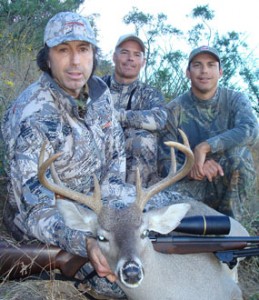
When we broke camp the next day all three hunters had successfully tagged out. It was a milestone for each of us. I had completed my deer slam, another hunter had harvested his first deer, and our third hunter had returned for his second Coues deer hunt and now had a matching trophy to accompany the deer he had shot a few years back with Pat.
With my “slam” completed I am now thinking about new goals and hunts. At the top of my list will be a return trip to Arizona to hunt with Pat again, this time for a desert Mule deer.
Darrell Pardy
Yarmouth Maine
